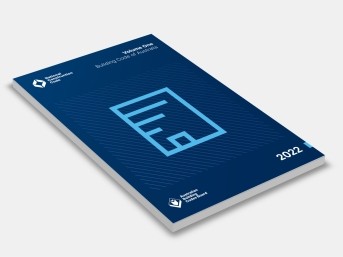NCC 2022 Volume 1 Building Code of Australia
Australian Building Codes Board
The NCC is Australia’s primary set of technical design and construction provisions for buildings. As a performance-based code, it sets the minimum required level for the safety, health, amenity, accessibility and sustainability of certain buildings. It primarily applies to the design and construction of new buildings, and plumbing and drainage systems in new and existing buildings. In some cases it may also apply to structures associated with buildings and new building work or new plumbing and drainage work in existing buildings.
The Australian Building Codes Board (ABCB), on behalf of the Australian Government and each State and Territory government, produces and maintains the NCC. When determining the content of the NCC, the ABCB seeks to—
ensure requirements have a rigorously tested rationale; and
effectively and proportionally address applicable issues; and
create benefits to society that outweigh costs; and
consider non-regulatory alternatives; and
consider the competitive effects of regulation; and
not be unnecessarily restrictive.
The primary users of the NCC include architects, builders, plumbers, building surveyors, hydraulic consultants, engineers and other building and plumbing related professions and trades.
The NCC is published in three volumes. The Building Code of Australia (BCA) is Volumes One and Two of the NCC and the Plumbing Code of Australia (PCA) is Volume Three of the NCC.
NCC Volume One contains technical design and construction requirements for all Class 2 to 9 buildings (multi-residential, commercial, industrial, and public assembly buildings) and their associated structures.
NCC Volume One contains the requirements for—all Class 2 to 9 buildings; and
•access requirements for people with a disability in Class 1b and 10a buildings; and
•certain Class 10b structures including access requirements for people with a disability in Class 10b swimming pools.
NCC Volume One contains the requirements for—
all Class 2 to 9 buildings; and
access requirements for people with a disability in Class 1b and 10a buildings; and
certain Class 10b structures including access requirements for people with a disability in Class 10b swimming pools.
PUBLISHED 1 May 2023.
The NCC provides the technical provisions for the design and construction of buildings and other structures, and plumbing and drainage systems.
NCC Volume One primarily covers the design and construction of multi-residential, commercial, industrial and public assembly buildings and some associated structures.
Each volume contains—
Governing Requirements; and
Performance Requirements; and
Compliance options to meet the NCC requirements; and
State and Territory variations and additions.
The NCC uses building classifications to identify requirements for different intended purposes of buildings or parts of buildings. A building classification relates to the characteristics and the intended use of the building. Information on building classifications is found in Part A6 of the Governing Requirements.
Legislative arrangements and the NCC:
The NCC is given legal effect through State and Territory, or other statutory authority, building and plumbing legislation.These Acts and Regulations set out the legal framework and administration mechanisms for the NCC to support the design and construction of buildings.
How to use the NCC:
Each volume of the NCC is split into two main sections:
Administrative requirements contained within the Governing Requirements.
Technical requirements contained within the remaining sections of the NCC.
The Governing Requirements provide the rules and instructions for using and complying with the NCC. They are vital in understanding how the technical requirements of the NCC should be applied to any particular situation. The Governing Requirements are also important in understanding how the NCC fits with the building and plumbing regulatory framework within Australia.
NCC clause numbering system:
The NCC uses a uniform clause numbering system across each of its three volumes. This system is called Section-Part-Type-Clause (SPTC). In each clause number—
The first letter indicates which NCC Section sits within, or if the letter S is used, that the clause is part of a Specification. The letter S is used in place of a Section indicator because the same Specification may be called up in several different Sections of the NCC.
The first number indicates the number of each Part within a Section, or the number of a Specification. Parts are numbered sequentially within each Section, starting at 1. Specifications are numbered sequentially across all three volumes, also starting at 1.
The second letter indicates the clause Type. It will be either G, O, F, P, V, D or C and these are explained below.
The second number is the clause number within each Part or Specification.
The clause Types used in the NCC are as follows:
G = Governing requirement (mandatory)
O = Objective (guidance)
F = Functional Statement (guidance)
P = Performance Requirement (mandatory)
V = Verification Method (optional)
D = Deemed-to-Satisfy Provision (optional)
C = Clause in a Specification (clauses in Specifications may be mandatory or optional, depending on how the Specification is called up by the NCC).
Informative parts of the NCC (e.g. Introduction to the NCC) are not numbered and do not have numbered paragraphs.This helps make it easy to see that their content is information only and does not contain any regulatory requirements.
Contents:
Section A: Governing Requirements
Section B: Structure
Section C: Fire resistance
Section D: Access and egress
Section E: Services and equipment
Section F: Health and amenity
Section G: Ancillary provisions
Section I: Special use buildings
Section J: Energy efficiency
Schedules—
Abbreviations and symbols
Definitions
Referenced documents
State and Territory variations and additions
Section A contains the mandatory Governing Requirements for the NCC. Sections B to G and I to J contain the mandatory Performance Requirements and the pathways that can be used to comply with the NCC.
There is no Section H in NCC Volume One because the letter ‘H’ is used in NCC Volume Two. This avoids number clashes between NCC Volume One and NCC Volume Two.
